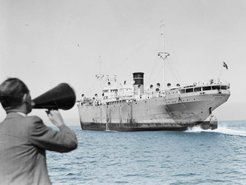Freedom of navigation: glocal practices and the normative structure of international law since the 17th century
PhD Project

To move at sea means to practice navigation, and freedom of navigation is considered one of the oldest and best-established – though not uncontested – norms of international law. The current literature often explains the norm’s emergence and subsequent change using top-down frameworks that link it to the struggle for hegemony in the international system and/or to the globalization processes of a capitalist logic. While these approaches have generated much valuable research, they struggle to take either contingency or the role of local normativity into account. Freedom of navigation, however, is thought about and takes place in local contexts. At the local level, it is prone to contingencies, that people not only practice normativity, but also imagine and indeed change it.
This project’s starting hypothesis is that freedom of navigation as a global norm emerges only in the moment of being practiced locally. It thus moves away from the assumption that norms exist in the international system irrespective of being practiced. A twofold theoretical step then follows this premise:
First, freedom of navigation as a long-term and global phenomenon becomes analyzable by employing the heuristic tool of ‘normative structure’. The term ‘normative’ here expresses a broader understanding of law that moves away from its nation-state centered forms to include other modes of exposure to, and production of, ‘positively marked possibilities’ (Christoph Möllers). The term ‘structure’ signals that the normativity analyzed possesses historicity, and hence a certain stability. The normative structure of freedom of navigation thus possesses a dual quality: heterogeneous groups of actors (communities of practice) are involved in constituting freedom of navigation, but are in turn themselves influenced by the history of the practices. This dual quality renders the practices ‘glocal’. Assuming the existence of the normative structure of freedom of navigation enables me to see how practices (normativity) emerged and changed in relation to this field of action. Furthermore, this approach, which builds on the concept of historical regimes of normativity, allows this to be done in a long-term perspective that can include and link different localities.
Second, the empirical data is provided by case studies that serve as snapshots of the normative structure in which specific communities of practice are embedded and which is, at the same time, being constructed by the practices of these communities. The latter should not be understood as necessarily homogeneous or free of internal power relations; rather, they can include actors as diverse as lawyers and jurists, diplomats, priests, captains, fishermen, queens, publishers, politicians and political activists, in differing constellations.
The selection of relevant communities of practice employs the method of ‘follow the conflict’ (Antje Wiener), in this case the articulation of contestation. Tracing conflicts back to specific incidents (see the list of case studies below) makes the emergence and subsequent development of practices regarding freedom of navigation observable.
As a result of its longue durée perspective, the project draws on a diverse range of sources, including legislation, treatises, pamphlets, logbooks, diaries and personal accounts.
The project’s overall aim is threefold: first, it seeks to add to the history of the law of the sea by exploring the role played by communities of practice in the production of freedom of navigation as a global phenomenon. While this builds on previously done research, it also addresses its blind spots. Second, for this purpose, the thesis develops a theoretical and methodological toolkit for conducting research on the emergence and change of global normativity. Third, as the project is situated at the intersection of the disciplines of historical international relations and the history of international law, it seeks to transcend disciplinary boundaries through a shared understanding of norms as practices.
Cases studies:
Part I
- The ‘Santa Catarina’ (1603): Producing Mare Liberum and Mare Clausum
- The ‘Merlin’ (1671): A Matter of Honour and Fish
- The ‘Dalawar’ (1735): Navigating Plague and Quarantine
- The ‘Felice Adventurero’ (1788): Sailing in Disguise and Looking for Fortune
Part II
- The ‘Gazelle’ (1864): Of Travels and Translations
- The ‘Costa Rica Packet’ (1888): Re-evaluating the Cannon Shot Rule
- The ‘Mavis’ (1893): Claiming Mother of Pearl in Troubled Waters
Part III
- The ‘Lusitania’ (1915): Humanity at Sea and the Failed Plan to Outlaw the Submarine
- The ‘Torrey Canyon’ (1967): From Inventing to Adjusting Traffic Separation Schemes (TSS)
- The ‘Tampa’ (2001): The Duty and the Law
- The ‘Borndiep’ (2009): Women on Waves
